Active Learning Resources
Want to motivate your students to engage the content of your course and increase responsibility for their own learning? Looking to enhance your current teaching practice with a range of techniques that will make your class prep more efficient? Aspiring to develop a vocabulary to describe the effectiveness of your teaching? Active learning can help!
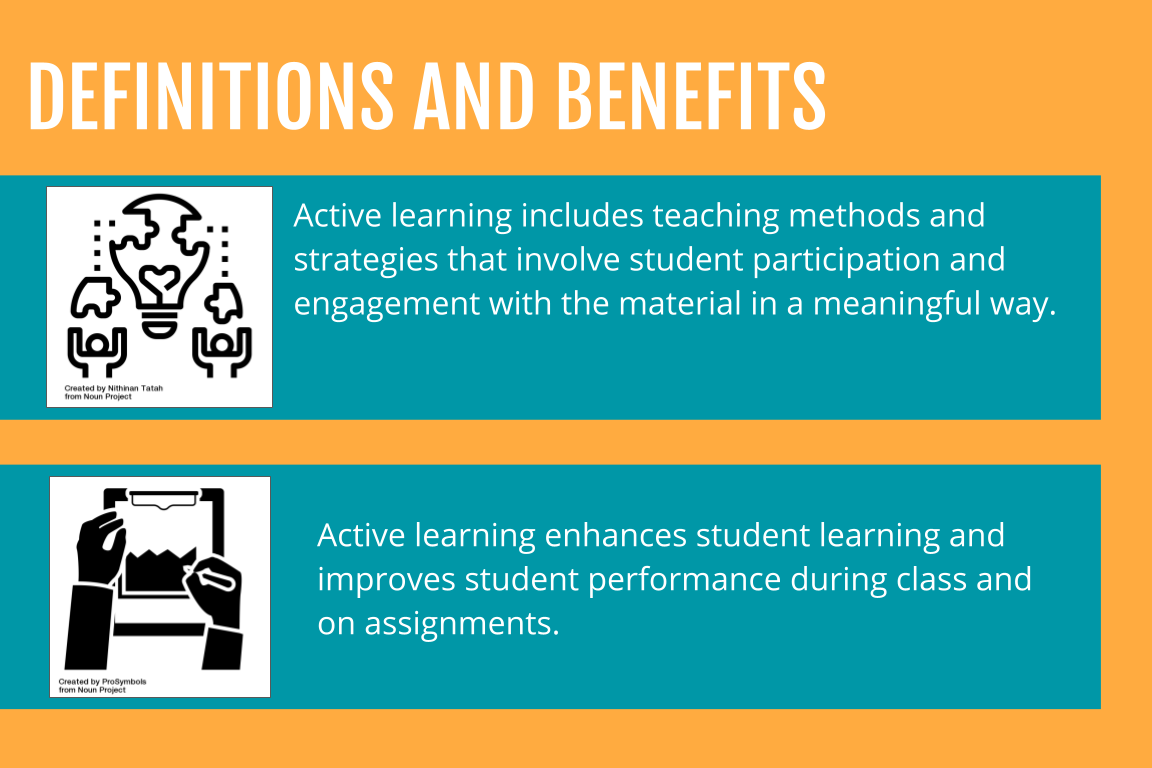
From simple techniques that get students involved in lecture to complex assignments that incorporate critical thinking and problem solving, active learning strategies increase student learning and develop instructor flexibility with diverse learning environments. Active learning includes any activity or approach that makes students engage the material through meaningful activities that require that they think about what they are doing and why (Bonwell and Eisen, 1991). Such activities occur in the classroom during instruction (Prince 2004), and involves all students (Felder and Brent, (2009). It works for classes range from 20 to 200 in all disciplines. There are certain active learning strategies, such as collaborative assignments and undergraduate research that are also high-impact practices because they have been shown to increase rates of retention and student engagement (Kuh).
Put simply, active learning enhances student learning. When students are involved in their own learning, it increases their interest and motivation and helps build competencies and skills. It improves performance on exams (Freeman). Instructors who use active learning strategies can obtain immediate feedback on the effectiveness of their teaching. Active learning techniques enhance content delivery and makes teaching more efficient.
Active Learning Classrooms
While active learning strategies can be used in traditional classrooms, active learning classrooms have elements that promote flexible teaching, including variable room arrangements and technologies. Classrooms feature furniture that can be moved around in different configurations to support student collaboration. They also include whiteboards around the room that help students to share their work. Though it varies from room to room, these classrooms also features technology that supports active learning.
To see an active learning classroom in action, watch this video on how Indiana University uses active learning classrooms.
Active Learning Scholarship
Bonwell, Charles C. and James A. Eison, Active Learning: Creating Excitement in the Classroom, ASHE-ERIC Higher Education Report No. 1. The George Washington University: Washington, D.C., 1991.
Davidson, Cathy. “10 Key Points About Active Learning,” Inside Higher Education, 25 Jan 2018
https://www.insidehighered.com/views/2018/01/25/how-think-about-active-learning-and-its-benefits-opinion.
Freeman, Scott et al. “Active Learning Increase Student Performance in Science, Engineering, and Mathematics.” PNAS: Proceedings of the National Academy of Sciences of the United States of America, vol 111, no. 23 (2014): 8410-8415.
Kuh, George. “High-Impact Educational Practices: A Brief Overview,” Association of American Colleges & Universities, https://www.aacu.org/leap/hips.
Prince,Michael. “Does Active Learning Work? A Review of the Research,” Journal of Engineering Education, vol. 93, no. 3 (July 2004): 223-231, doi:10.1002/j.2168-9830.2004.tb00809.x
Active Learning Environments
Face-to-Face in Classrooms
Active learning strategies can be implemented in any kind of classroom, but active learning classrooms offer amenities that can enhance learning. Such amenities include moveable furniture for collaborations and multiple screens for sharing content. Large active classrooms, which seat 60 or more students, can also benefit from active learning strategies. Lectures, the most common form of teaching in such courses, can be enhanced with active learning strategies.
Physical space can have an impact on the learning experience:
- Focal point: In a traditional classroom, one focal point, usually at the front of the classroom, draws all attention to the instructor as the primary conduit for information. Active learning classrooms lack a focal point, and additional technology can create distractions for students.
- Student engagement: Active learning encourages students to participate in their learning. This also requires instructors to plan, manage and hold students accountable as they face each other, which can affect their ability to stay on task.
- Technology: Increased technology in active learning classrooms, such as multiple projectors and whiteboards, can enhance student engagement. Such technology may not be utilized because they seem daunting or overwhelming.
Active Learning and Multiple Modalities
Strategies used in online synchronous and asynchronous environments can be used to support student learning in active learning classrooms. Instructors can use these strategies by :
- leveraging the tools in the learning management system, such as video creation and discussion forums, in addition to class lectures.
- creating interactive lectures with breaks where students can ask questions using the chat box.
- utilizing polls and shared documents to to engage students with the material and check understanding.
- using tools outside of the learning management system, such as Padlet, VoiceThread or Harmonize, to supplement in-class activities.
- creating videos that students watch before class that include guided or embedded questions, leaving class time for more collaborative work.
Active Learning in Large Classes
Active learning strategies can be incorporated in large classes as well. One effective strategy involves the interactive lecture. While traditional lectures focus on transferring information, interactive lectures focus on engaging students by providing opportunities engage with the material. They also provide opportunities for the instructor to check understanding.
For every 10-15 minutes of lecture, the instructor can pause and ask a question, initiating a small group discussion or a classwide discussion among the students. The technology in large active learning classrooms, including microphones throughout the room, ensures that students can hear one another. The ability to move the furniture facilitates small-group discussions. Students can also use the displays around the room to share the results of their discussion.
Using Technology for Active Learning
Instructional technology can get your students involved in their own learning in a fun way.
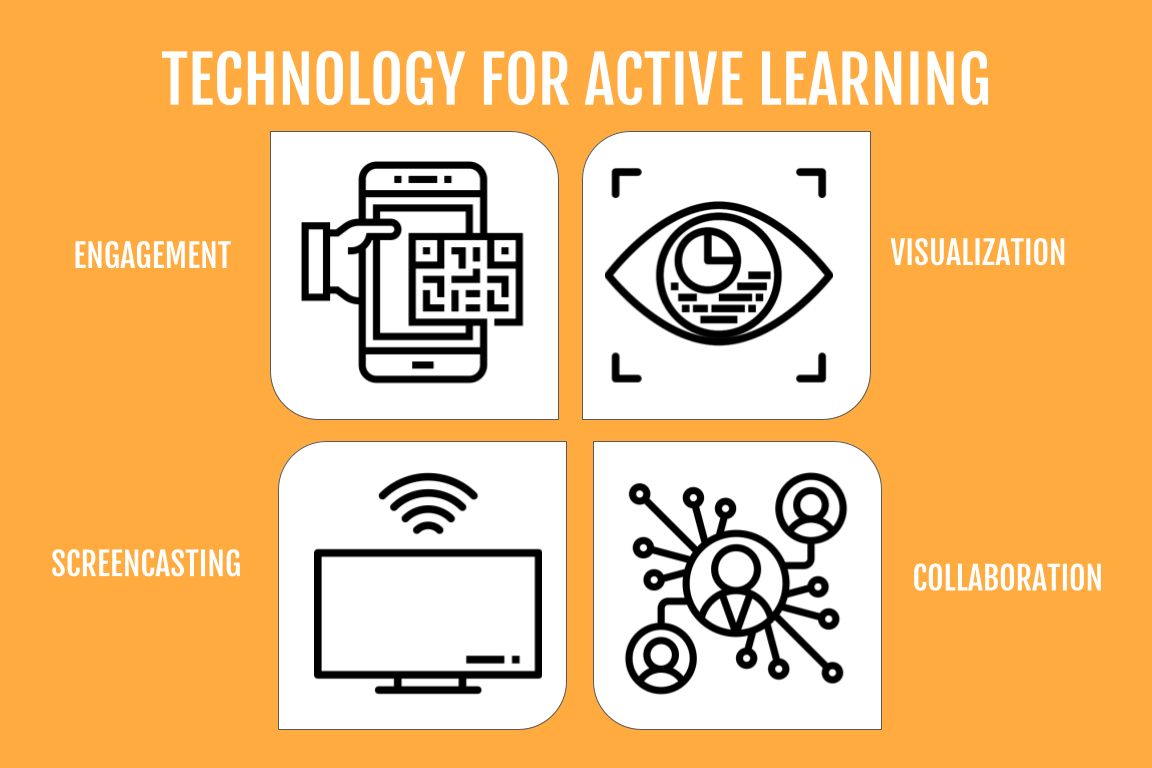
Icons ( Eucalyp from www.flaticon.com; phatplus from www.flaticon.com; mynamepong from www.flaticon.com; Eucalyp from www.flaticon.com)
Engagement: iClicker (Personal response system), Poll Everywhere (Web-Based Polls), Kahoot! (Online games)
Visualization: Prezi (presentation software); Mindomo (mind mapping and concept mapping), Padlet (online post-it board), Jamboard (digital whiteboard)
Screencasting: Kaltura, Screencast-o-matic
Collaboration: Google Docs, Blackboard Collaboration Ultra, WordPress Course Blogs, Microsoft Teams, Slack
Designing for Active Learning
Successful implementation of active learning strategies requires advance preparation ranging from simple to complex. Consider the following when using active learning strategies in your course.
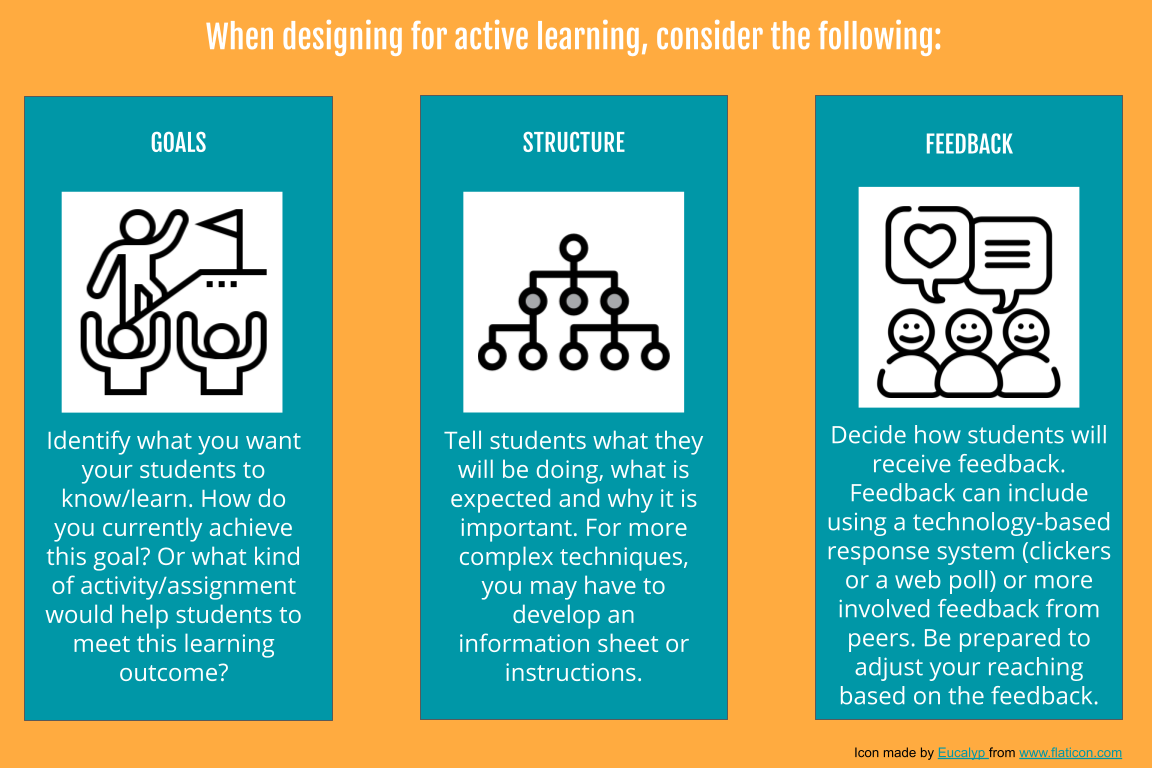
With just a little advanced prep and an intentional goal, you can incorporate active learning into your courses. Start small.Choose one active learning strategy to use throughout your course, or choose a few key points, modules or low-stakes assignments as starting places for including active learning.
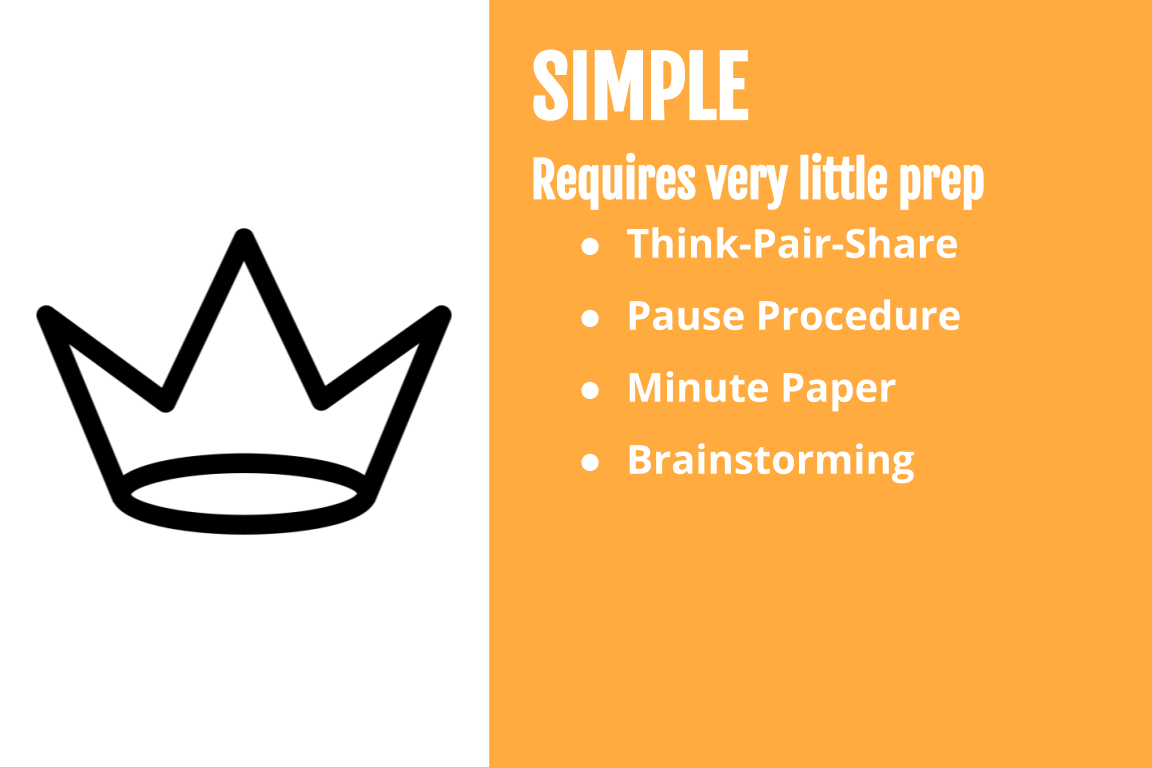
Icons made by Freepik from www.flaticon.com
- Think-Pair-Share. Instructor poses a question. Students think or write down their response, discusses their answer with a neighbor and then shares with the class. See a demo in the video Think Pair Share/Post It Pile It (at 2:15). Variations include Think-Write-Pair-Share and Think-Pair-Square-Share.
- Pause Procedure. Instructor pauses regularly (18-20 minutes) during a lecture and encourages students to do something, including review notes, raise questions or write a response. See Active Learning: The Pause Procedure for more ideas.
- Minute paper. Students write for one or more minutes about a prompt posed by the instructor. Variations include Muddiest Point/Clearest Point, where students write about a point they don’t understand or understand very well. See Cindy Fernandes’ video on the One Minute Paper for more details.
- Brainstorming. Students generate and record ideas on a topic.
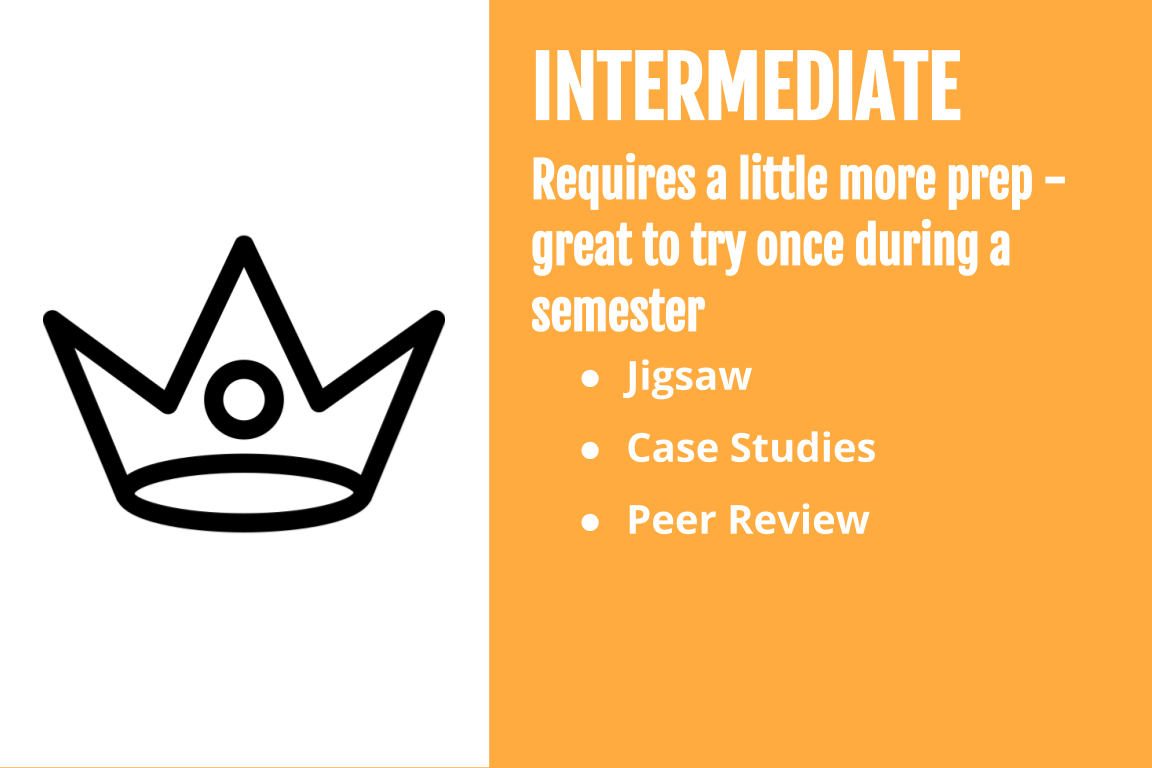
Icons made by Freepik from www.flaticon.com
- Jigsaw. An assignment/activity is divided into parts and the class is divided into the same number of teams. Each team is given one part to learn, then the teams are shuffled so that these students teach other teams their part. See a demo at The Jigsaw Method.
- Case Studies. Students read about real-life situations and come up with a way to resolve issues. See Active Learning in Practice: Case Studies for more details.
- Peer Review. Students provide each other with feedback on an assignment. See Baruch College’s Center for Teaching and Learning – Ideas for Peer Review for more information.
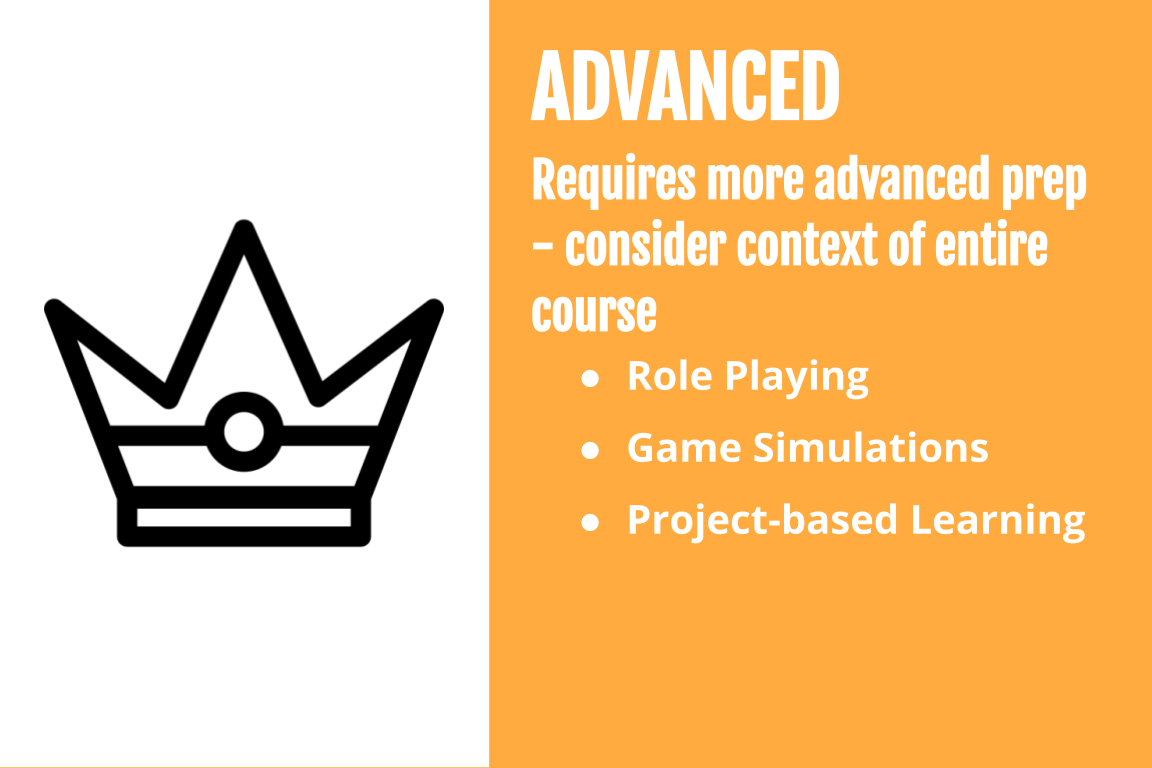
Icons made by Freepik from www.flaticon.com
- Role playing. Students act out a concept to show their understanding. See Using Role Play Simulations to Promote Active Learning for more details.
- Game simulations. See DePaul’s Teaching Commons for more information.
- Project-based learning. Students work through a real-world problem to find solutions. See Edutopia’s Project-Based Learning for more ideas.
Active Learning Challenges and Strategies
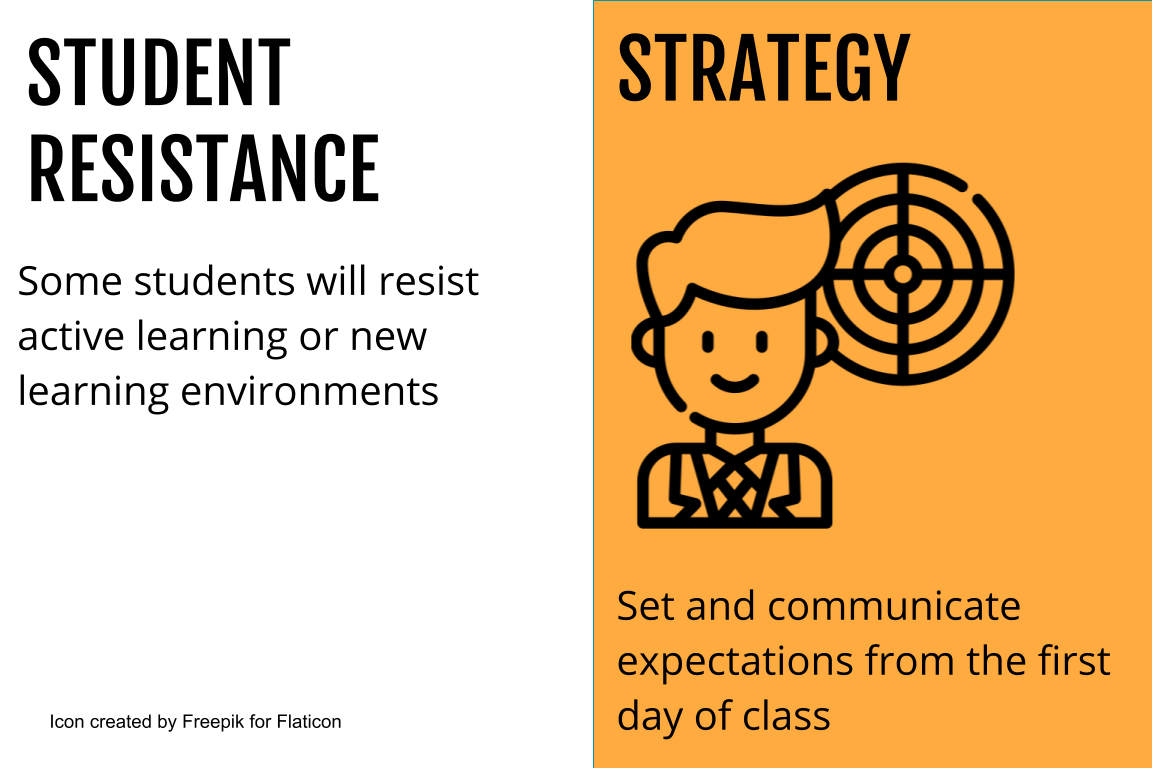
Send a welcome e-mail to your class explaining your approach and what students can expect, or provide an introductory video for students to watch prior to the first class meeting. Explain how and when they’ll take in content—and reinforce that it generally won’t happen during class.
Do something meaningful on the first day—design an activity that will highlight key features of your course and let them experience what the class will be like. One way to initially set the expectation that students are responsible for taking in content outside of class is to assign the syllabus as reading; then design an online quiz, a question set, or a student activity to hold students accountable for reading and understanding the syllabus and other important course documents.
Discuss and define active learning—and your rationale for it—and to compare it to their prior learning experiences. This discussion, and your syllabus, should include information on what students will be expected to do outside of class to be prepared for what happens inside the classroom and how much outside study time they should allocate for your course.
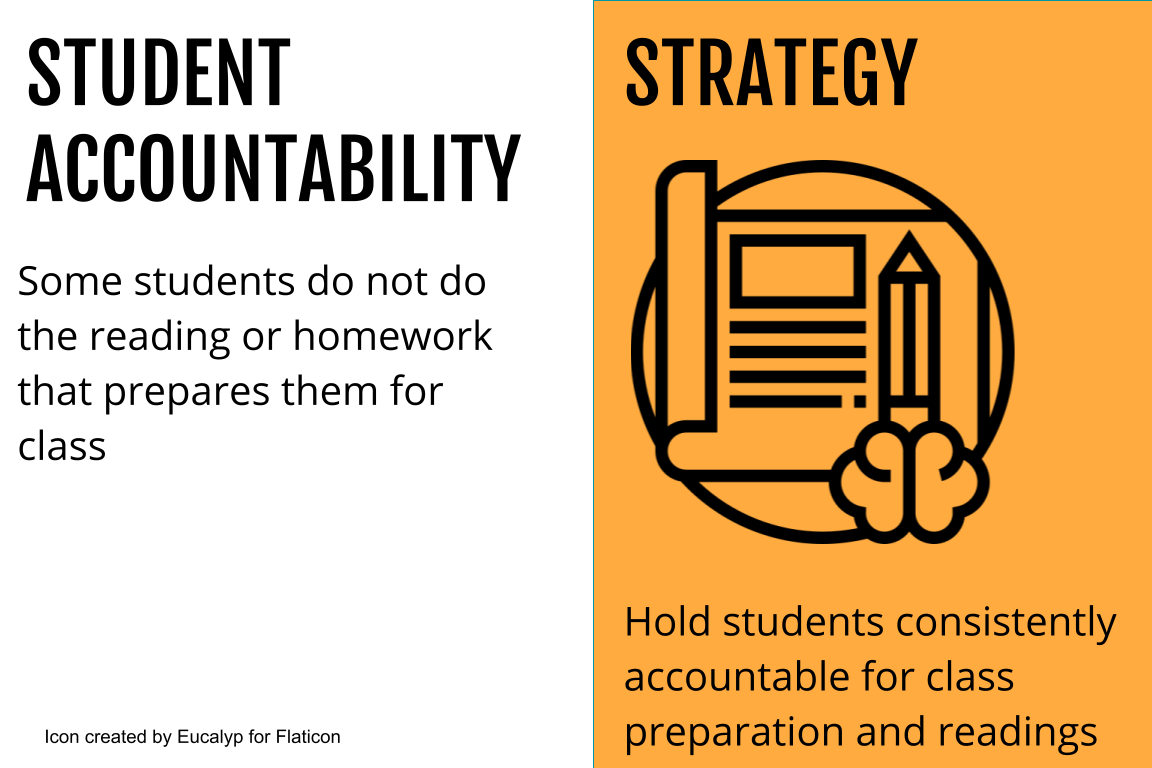
Give online reading quizzes in advance of class or assign reading journals or reflections.
Give collaborative quizzes at the start of class to hold students accountable and prepare them to work together for the class period. Have students decide who gets credit on the quiz or articulate who contributed in a valuable way (and why or how).
Use i-Clickers, Poll Everywhere, or other tools for assessing in-class student knowledge and preparedness.
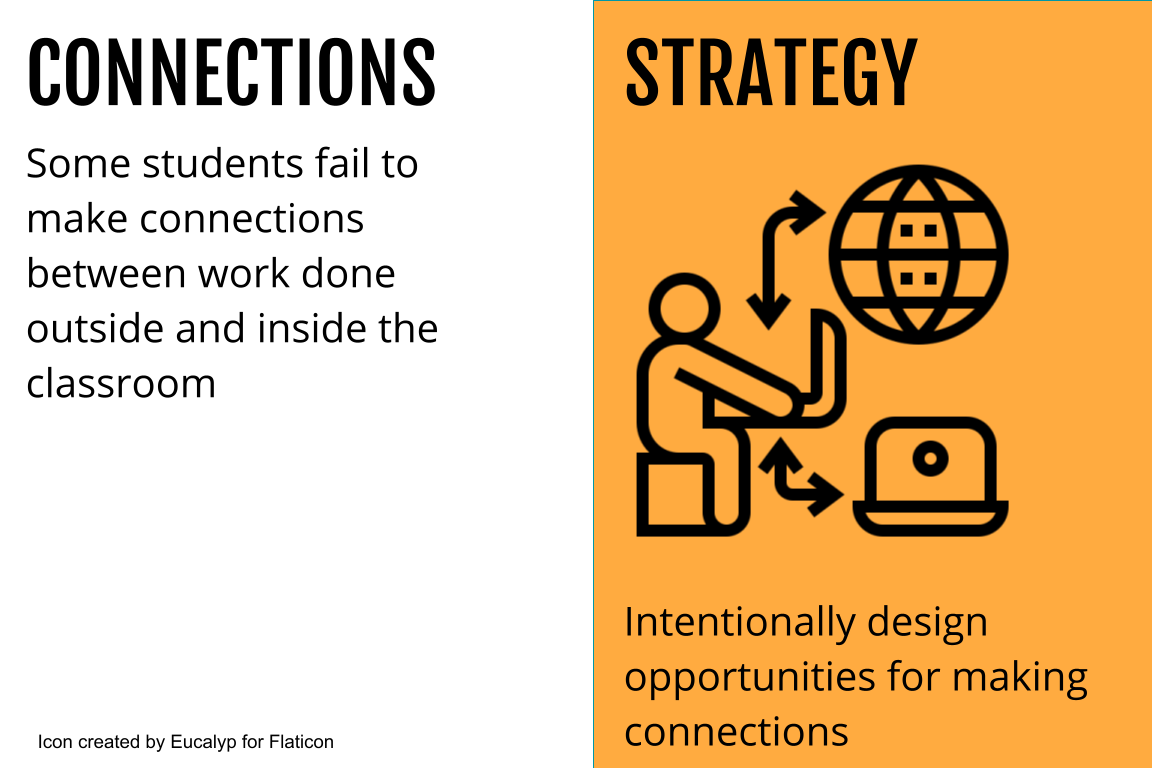
Ask students to point back to earlier elements of the course and explain how they are applying them to current assignments, or include connections and references to earlier material and assignments on new activities or assignment.
Spend class time on exercises dedicated to students explicitly making—even literally mapping—connections.
End activities or classes with students reflecting on how the work done in class connects with a major assignment, course learning goals, and to work outside of your course.
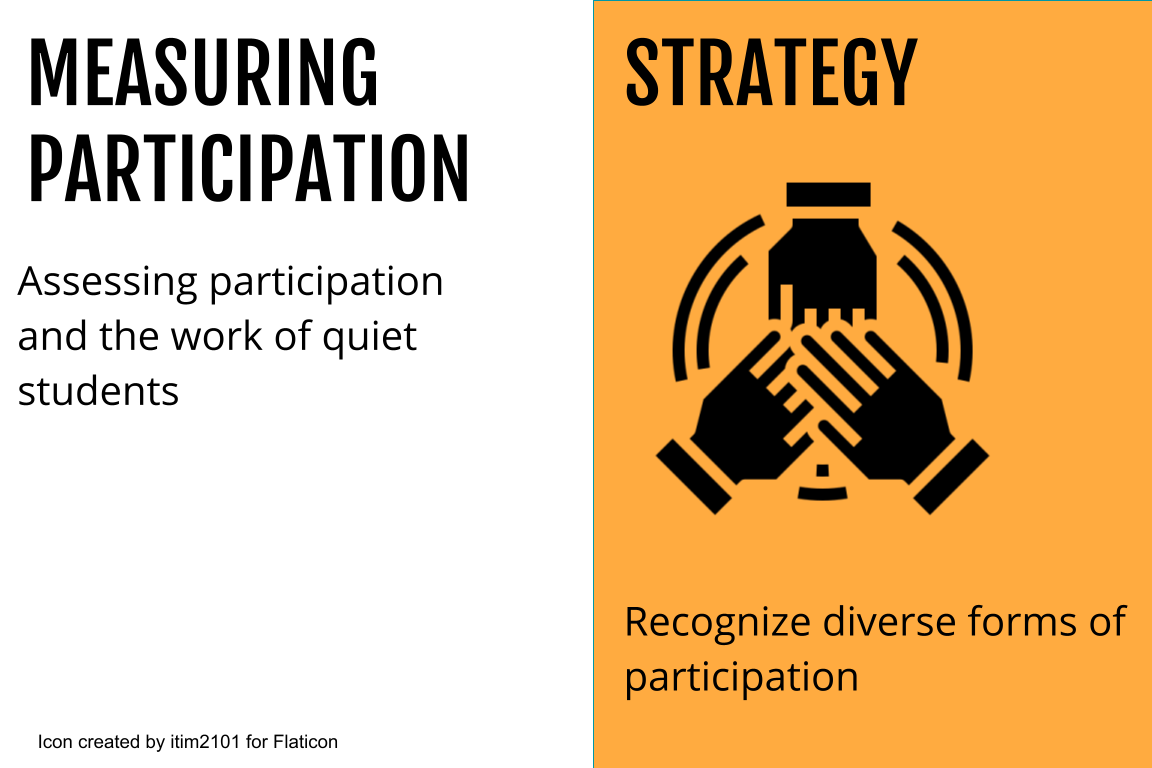
Set clear expectations on your syllabus regarding what constitutes participation and how it will be assessed or graded. Clearly state (and reinforce) that commitment, preparedness, level of engagement, trying hard, and respect for the classroom environment are all important participation and engagement components.
Start discussions or group activities with an individual component that allows students to think and write in advance of sharing or working with others.
Use nametags in large classes, take notes or use a participation log or app as you circulate to groups, assign group member roles, and require that students post process work or reflection on in-class activities.
NEW RESOURCE! As part of Mason’s strategic plan, we are committed to designing learning spaces that support active learning. Check out Mason’s Learning Environments website for more information. (Note: The Active Learning with Technology (ALT) experience video has been moved to this new website. Please click on the “Faculty Experience” tab to view.)
ADDITIONAL RESOURCES
- Introduction to Flipping Your Class (UNC-Chapel Hill CFE)
- Flipping the Classroom (Duke University)
- Class Time Reconsidered (Derek Bruff)
- Understanding the Flipped Classroom (Faculty Focus)
- 5 Ways to Make Your Classroom More Student Centered (Justin Tarte)
- Select Web Resources on Active Learning Strategies in the Sciences (The Innovative Educator)
- How to Make Your Teaching More Engaging, Advice Guide (Chronicle of Higher Education)
- Can the Lecture Be Saved? (Chronicle of Higher Education)
